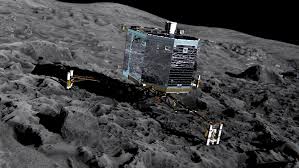By Shradha Singh, Staff writer
History was made this month as one of the greatest space accomplishments since Neil Armstrong’s walk on the moon was achieved. On Wednesday, November 12, the space lander Philae touched down on Comet 67P/Churyumov Gerasimenko. This makes it the first time ever that a space mission has made a soft landing on a comet. However, this important event did not come without its own difficulties, the most recent of which may end the mission entirely.
The robot, about the size of a washing machine, was launched by the European Space Agency (ESA) ten years ago, in 2004, with the purpose of pursuing the elusive comet. After traveling more than 6.4 billion miles, the probe first came close to its target back in August. On Wednesday, the Philae lander finally separated from its larger space probe, Rosetta, touching down on the comet…and then bouncing back off. Luckily, the lander found its way back onto the surface again more than an hour later…only to be launched a kilometer back into space. After making a small trip back in zero gravity, the lander made a third trip onto the comet, this time to stay.
The reason for all this drama has been attributed to the failure of the lander’s ice harpoons to deploy. The result has been a precarious hold on a surface that is mostly ice and dust.
Another complication has been the matter of battery power, or rather the lack of it. The lander’s final resting place has been in the shadow of a cliff, which allows for Philae’s solar panels to garner a mere 1.5 hours of sunlight in Comet 67P’s 12-hour day. This is nowhere near the 7 hours of sunlight promised in the original landing site, nearly a kilometer away. As a result, after 60 hours of operation, Philae’s batteries ran out on Friday, November 15, making the lander incommunicable to Earth for the foreseeable future. Still, scientists hope that as the comet comes closer and closer to the sun, Philae will once again operate and send back data.
Although Philae is no longer in communication, scientists are still excited as to what was accomplished before the lander stopped responding. According to the European Space Agency, right after it landed, Philae’s Cometary Sampling and Composition (COSAC) system, one of the two gas analyzers present on the lander, was able to detect the presence of organic molecules in the comet’s atmosphere. The lander was also able to dig up some surface samples, although it is still unclear whether or not this was analyzed before its batteries died as well.
With this data, scientists are hoping to test a circulating theory that these meteors are what brought water to Earth, thousands having bombarded Earth early in its life. If this is proven true, then it would be able to explain the origins of oceans on Earth’s surface, something which has long puzzled some researchers.
